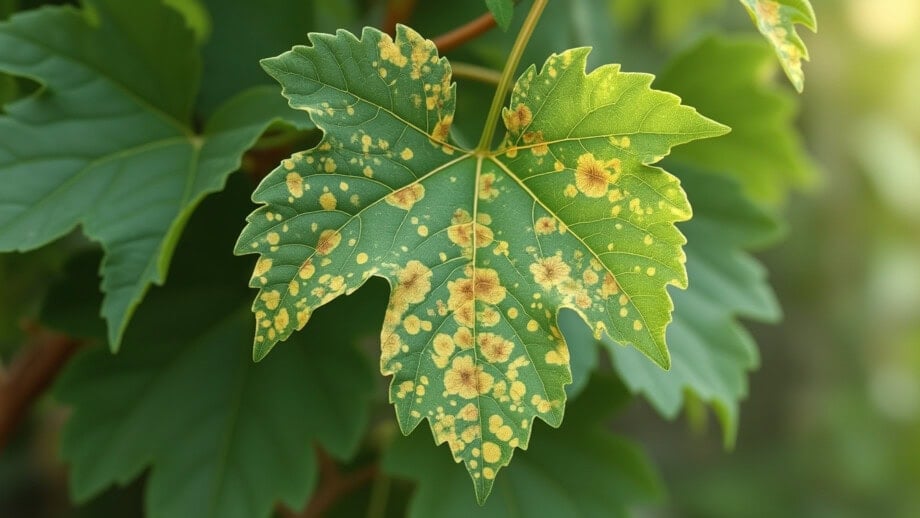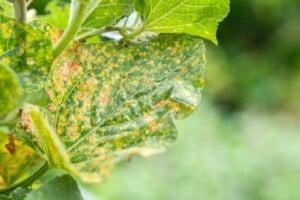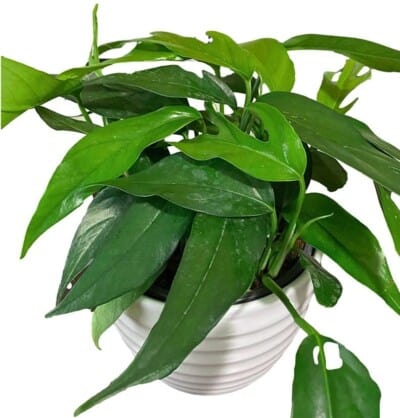Downy Mildew
Learn how to identify and control downy mildew disease naturally — without resorting to toxic sprays!

Downy mildew is an umbrella term for a large number of plant diseases. It is not a true fungus. They attack vegetables, fruits, and flowers. By the time a plant shows symptoms, it is too late. Prevention is key.
What Is Meant by Downy Mildew?
Downy mildew is a type of oomycetes or water mold. Once considered a fungal disease, it is now classified in the family Peronosporaceae. There are thousands of different types of water molds, most of which are called downy mildew. Most specialize in a particular species or a group of plants. They are a significant cause of plant pathology.
Is Downy Mildew Harmful?
Yes, downy mildew is harmful. It is an obligatory parasite and has to have living plants while going through its life cycle. These plant diseases can devastate a crop and kill most of the plants within a week. It is considered an economically important group of pathogens for that reason.
Symptoms
The symptoms of this pathogen differ somewhat on different hosts. However, they all cause yellow spots on the upper leaf surface between the leaf veins. These spots spread everywhere but the veins and eventually turn brown. The plant cannot photosynthesize on these yellow or brown spots. When the leaf is totally brown, it drops. If the plant loses too many leaves, the plant dies.
The bottom of the leaf surface has a fuzz on it that varies from white to purple, depending on the species of mildew. Many of the fruits on the plant rot from the mildew or get sunscald and quit growing because the leaves no longer shade them.
If you cut an infected plant, you will see the vascular system is totally choked with spores, making it impossible for the plant to transport water from the roots to the leaves.

Life Cycle
The lifecycle is a bit complicated but it is essential to stop downy mildew.
- The mildew overwinters as mycelium (filaments of tissue) or oospores (thick-walled round structures) in or on the plant. When the temperature is between 50-75, and the relative humidity is 85% or above, the oospores germinate.
- Germinating oospores produce sporangiophores.
- Sporangiophores emerge from the plant stoma, or pore, and look like a bunch of grapes.
- These sporangia are wind and water-borne. Each individual sporangia holds many zoospores.
- Zoospores blow to a leaf surface during wet and mild weather.
- The zoospores germinate on the plant.
- Zoospores swim from infected plants or soil to new plants and infect them.
This cycle can take as little as four days in favorable weather but typically takes 7-10 days. An entire field can be infected before the first symptoms appear.
Disease transmission
Downy mildews are air and water-borne pathogens. They cannot overwinter in the northern part of the United States. They do overwinter in the southern United States, usually in fallen leaf litter. Downy mildews spread progressively north once the weather warms until they cover much of the United States by August. When the cold winter comes, they die back in the north.
Spores can also be transmitted by tools or hands that have come into contact with infected plants and are not sterilized before moving to a healthy plant. Enclosed environments such as greenhouses can spread spores to fields.
Important Strains of Downy Mildews
These types of downy mildew are economically important. They often attack home gardens as well as commercial growers.
Cucurbit (Pseudoperonospora cubensis)
Cucurbit downy mildew infects cucumber, melon, gourds, pumpkin, and squash. In watermelons, the leaves curl more than on other crops as well as displaying the rest of the symptoms.
Brassicas (Hyaloperonospora parasitic)
These include cabbage, broccoli, Brussel sprouts, kale, kohlrabi, Chinese cabbage, turnip, radish, cauliflower, and mustard.
Grapes (Plasmopara viticola)
This infects the leaf, stem, flowers, and fruit and kills off the vines.
Basil (Peronospora belbahrii )
First reported in Uganda in 1930, it really took off in Italy in 2004 and has been increasing in prevalence since then all over the world.
Hops ( Pseudoperonospora humuli)
The mildew destroys hops grown for beer-making.
Impatiens (Plasmopara obducens)
This has been known since the 1880s but swept the UK in 2003 and the US in 2004. By 2016, it was destroying plants all over the world.
Roses (Peronospora sparsa)
Downy mildews are one of the most devastating of rose diseases. They also attack other closely related Rubus species, including blackberry, raspberry, and boysenberry.
Spinach (Peronospora effusa)
This causes a huge problem for spinach growers. Organic growers are especially hard-hit.
Sunflowers (Plasmopara halstedii)
The spores for this type of mildew stay in soils for years.
Powdery Mildew versus Downy Mildews
Powdery mildew (Podosphaera xanthii or Erysiphe cichoracearum) is one of a number of other fungal diseases often confused with downy mildew. Mixing them up is a problem because the treatments for each are different. Powdery mildew is a whitish growth that looks like a powder. The spots start as circles on the surface of the leaf and then grow to cover the whole leaf, including the veins. The leaves only turn yellow after they have had powdery mildew for a while. Powdery mildew can kill plants by blocking the chlorophyll in the leaves from sunlight. The plant starves to death as a result.


Prevention
Stopping downy mildew is much easier than controlling it. Help prevent downy mildew in your landscape by following these tips.
Resistant Plants
Scientists have bred some resistant cultivars of plants that are susceptible to this disease. While every type of plant does not have a choice that is resistant, use resistant cultivars wherever possible. Make sure that you do not get any infected seed by buying from a reputable nursery.
Scout Plants
It is important to scout your plants often. If you see symptoms, remove that plant immediately, put it in a plastic bag, and put it in the trash. Do not compost diseased plants as most home compost piles are not hot enough to kill the downy mildew pathogen.
Air Circulation
Wet leaves are necessary for this type of mildew to invade plants. Eliminate moisture by pruning plants to improve air circulation. In row crops, make sure to space plants to allow for good air circulation even after they are mature. Make sure the rows are far enough apart, as well.
Watering
One of the worst things you can do is water plants from the top. A whole host of diseases must have wet leaves to infect the plant. Overhead irrigation wets the leaves. If you must water from the top, water in the early morning hours, before 10:00 a.m. so the leaves will dry before nightfall.
The best way to water plants is using drip irrigation. The water comes out at the emitters at ground level and sinks right to the roots. Drip irrigation also saves money because it takes less water.
Mulching helps keep soil off your plant’s leaves so mildews don’t get a foothold. Mulch conserves water and keeps roots warm in winter and cool in summer. Three inches of mulch around your ornamental plant repays the cost of replacing plants many times over.
Eliminate Overwintering Sites
Sanitation is key to controlling downy mildew. The spores overwinter in plant debris. Infected leaves have spores on them that can get splashed on uninfected leaf surfaces. After your crops are done, rake up all leaves and plant debris and discard them. If you are dealing with ornamental plants, make sure all the leaves are off the mulch when they have finished falling.
Quarantine new plants for a while before putting them in the ground or the greenhouse. Since a plant can be infected up to 10 days without showing symptoms, a regular 14-day quarantine is helpful in reducing plant disease.
Control for the Home Garden
It is much harder to control downy mildew than it is to prevent it. Fungicides have to be used frequently during the growing season when there is high humidity combined with mild temperatures, such as spring and fall. The frequency of application depends on the species and whether downy mildew has been found in your area or not.
Fungicides are a preventative since most don’t control the disease once it is present. The other issue is fungicide resistance. You need to rotate the fungicide you use to prevent that.
There are systemic fungicides that are licensed for some plants. They can be used to keep the spores from growing in the vascular system of the plant. However, they are not organic and cannot be used on many vegetables.
Which fungicide is used against downy mildews?
When using any fungicide, you must spray until the entire leaf is wet on top and on the underside of the leaf. Spores exist on both surfaces. The following are some organic control methods.
Copper fungicides are often used to control downy mildew. While many people believe copper is approved for organic production, it is only conditionally approved. Care must be used in cucurbit crops because copper makes them photosensitive. Copper levels can build up in the soil and kill earthworms and other beneficial organisms.
Neem oil is labeled for use as a fungicide in many plants. However, neem oil suffocates all insects that it touches, including bees and beneficial insects. It should not be used without clear need and should be put on in the evening when bees are inactive.
Bacillus subtilis is a type of fungicide that is licensed for organic vegetables. It is made from chemicals put out by microorganisms.
Not all types of downy mildew are controllable. As mentioned, many strains develop resistance to fungicides. Even if the fungicide you put on your plants works, new infections can come on the wind, so you must be vigilant all season long.
Does baking soda work on downy mildews?
Another name for baking soda is sodium bicarbonate. While a number of places have suggested sodium bicarbonate as a remedy for powdery mildew, it has not been found to provide effective downy mildew control.
Potassium bicarbonate has been approved as a downy mildew control. This is harder to find than baking soda. However, it has been exempted from residual controls by the Environmental Protection Agency (December 1996, EPA).
Downy mildew is a collection of water molds that invade plants. Often, the plants die before they even show symptoms. Mild wet weather is needed for downy mildew to infect a plant. It swims on the top of the leaf until it finds a pore and then invades. Drip irrigation helps prevent the disease by keeping water off the leaf. Fungicides help prevent the disease from taking hold by killing it on the leaf.
Treatment
The best way to prevent downy mildew is to avoid the environmental conditions that favor the disease.
- Prune or stake plants and remove any weeds to improve air circulation.
- Water in the early morning hours, or use a soaker hose, to give the plants time to dry out during the day.
- Keep the ground under infected plants clean during the fall and winter to prevent the disease from spreading.
- Remove and destroy any plants with serious infection (see Fall Garden Cleanup).
- Choose resistant varieties whenever possible.
- Downy mildew is comparatively easy to control on most plants when the foliage and fruit are kept protected by a copper spray. Begin treatments two weeks before disease normally appears or when weather forecasts predict a long period of wet weather. Alternatively, begin treatment when disease first appears, and repeat at 7-10 day intervals for as long as needed.
- The systemic action of Organocide® Plant Doctor moves throughout the entire plant to treat common disease problems. Mix 3/4 tsp per gallon of water and apply to foliage. Spray to run-off, as required for disease control.













